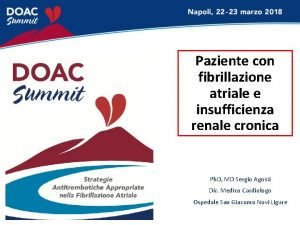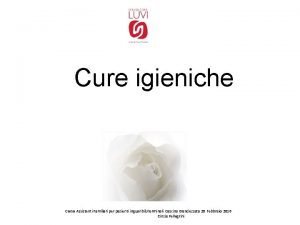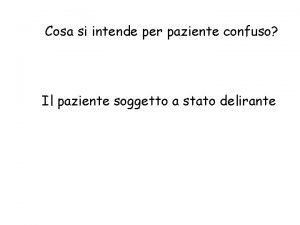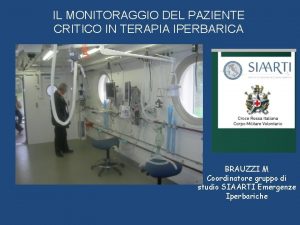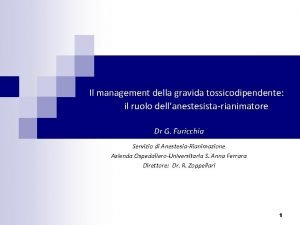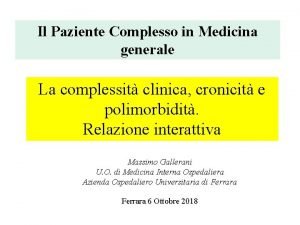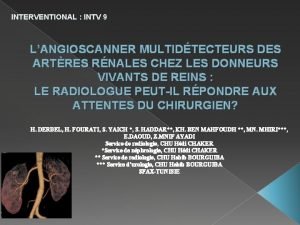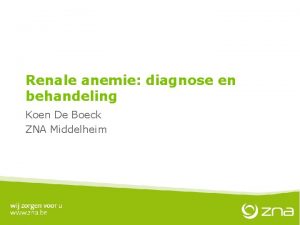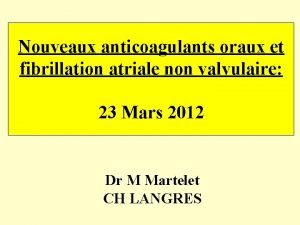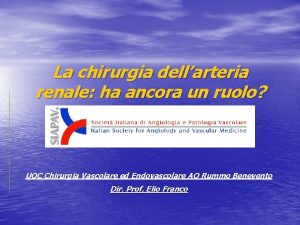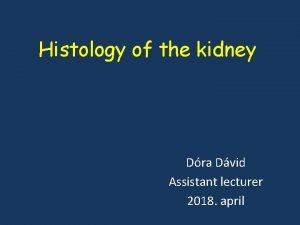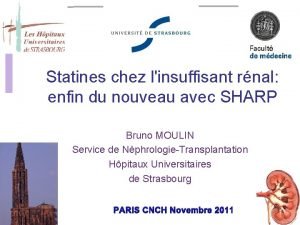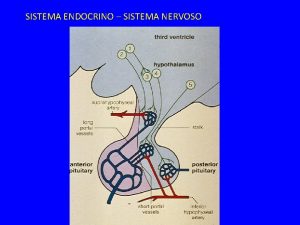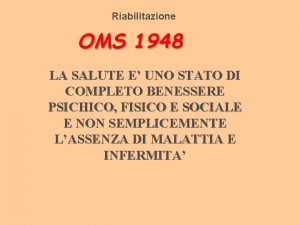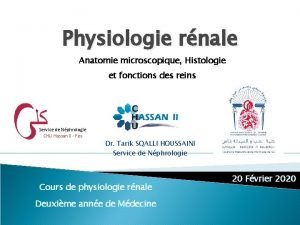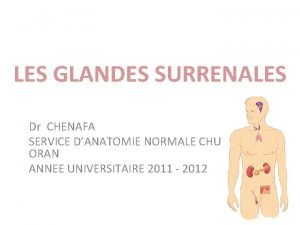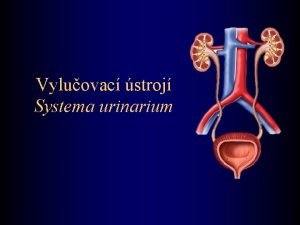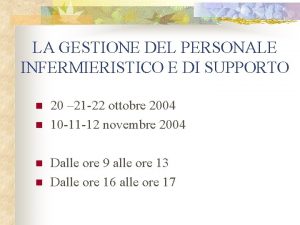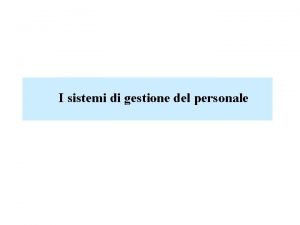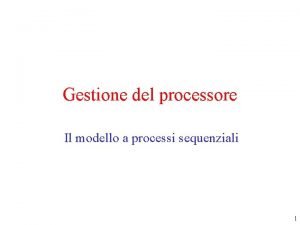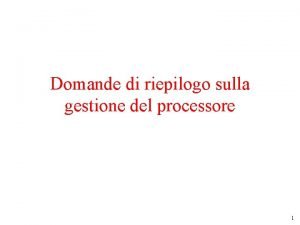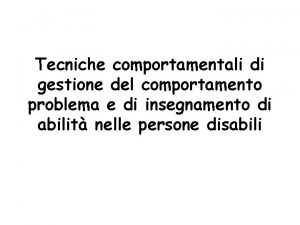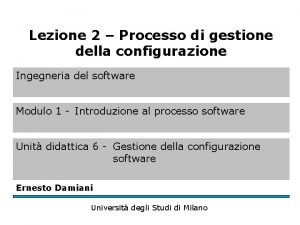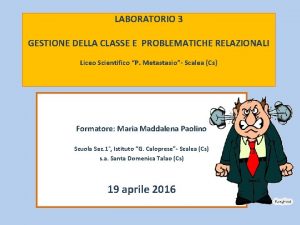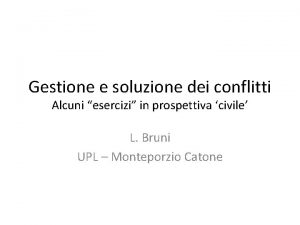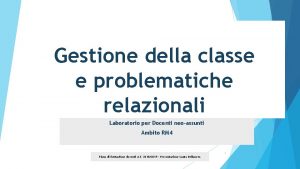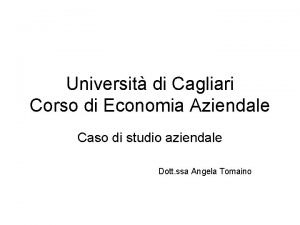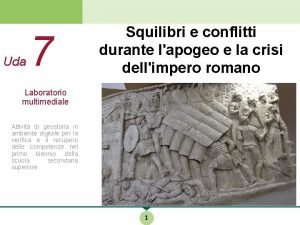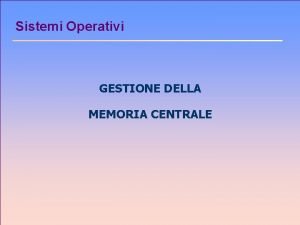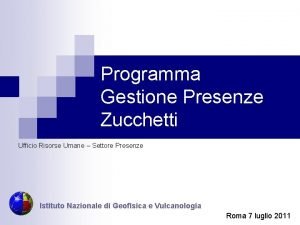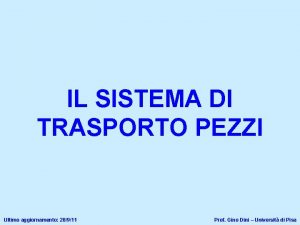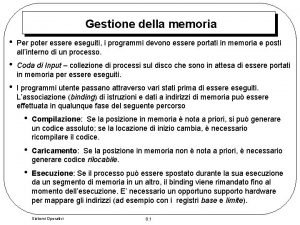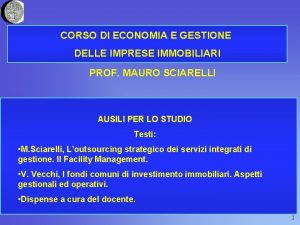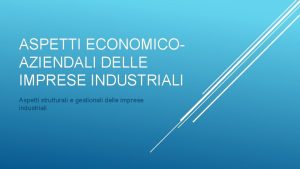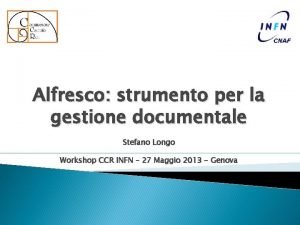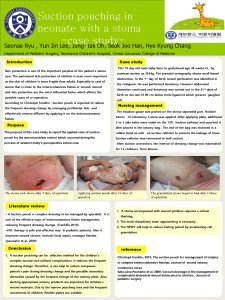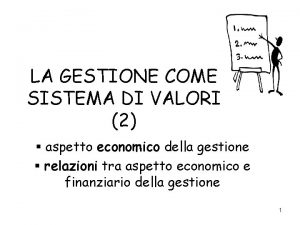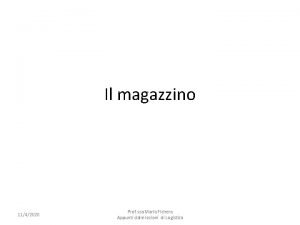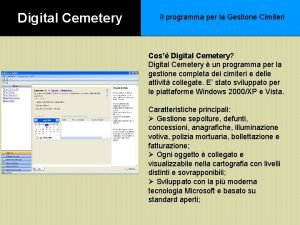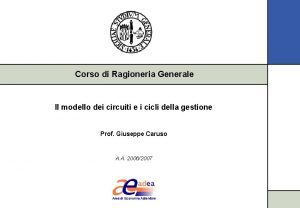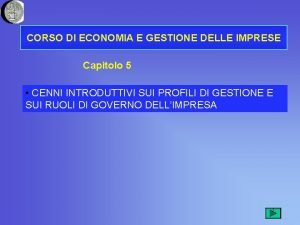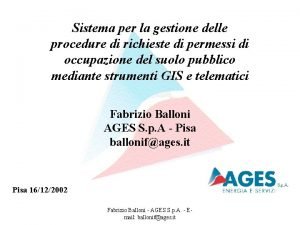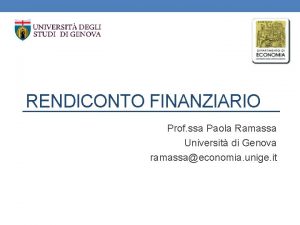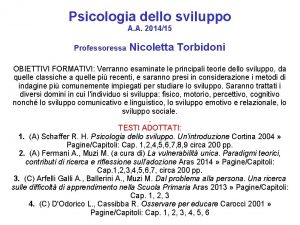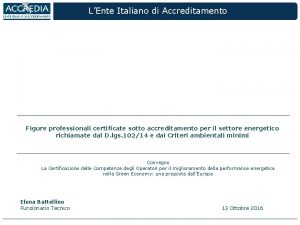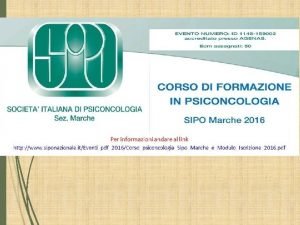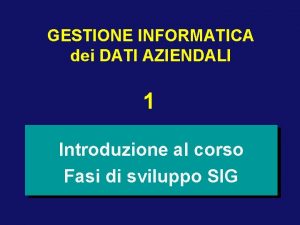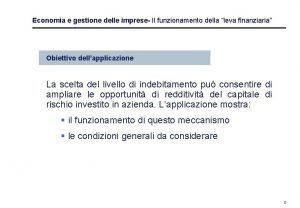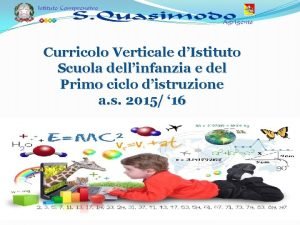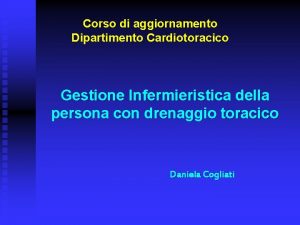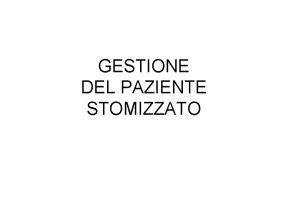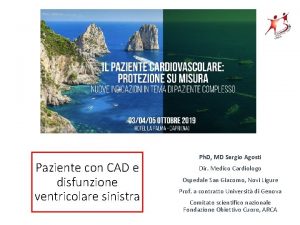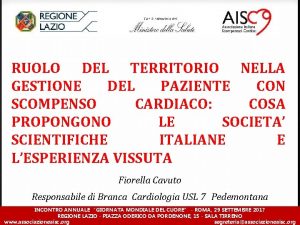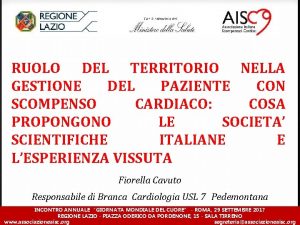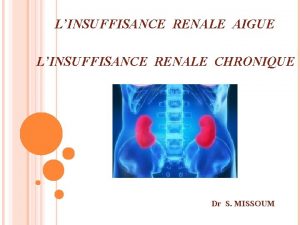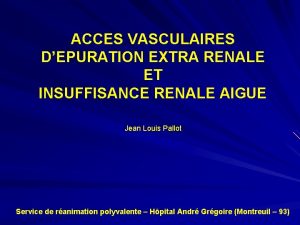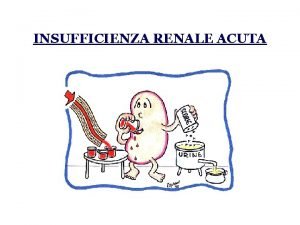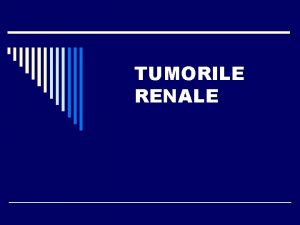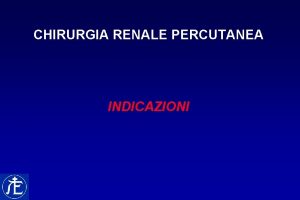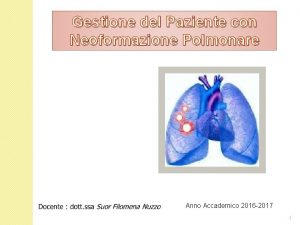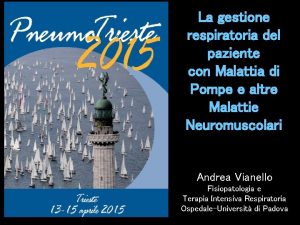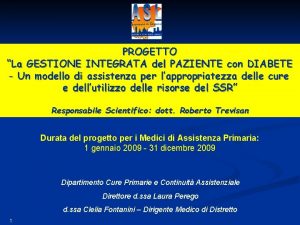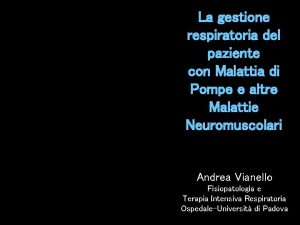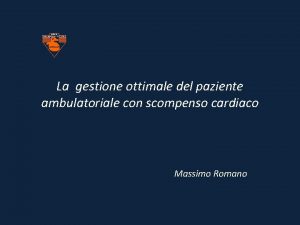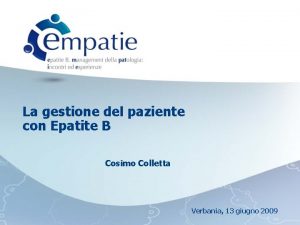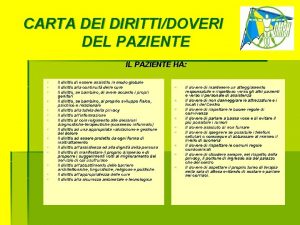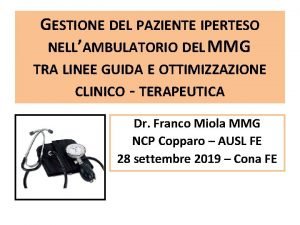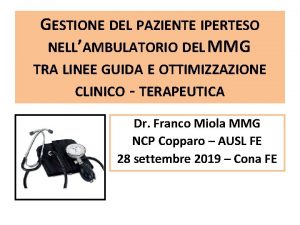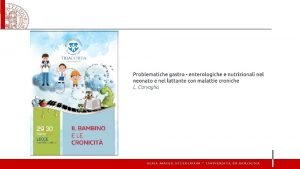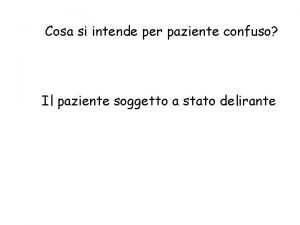La gestione del paziente con disfunzione renale R




































































- Slides: 68

La gestione del paziente con disfunzione renale R. Breglio (Napoli)

Definizione di scompenso cardiaco “L’insufficienza cardiaca congestizia rappresenta una sindrome complessa caratterizzata da alterazioni della funzione ventricolare sinistra e della regolazione neuro-ormonale , che si associano ad intolleranza allo sforzo, ritenzione idrica e ridotta longevità” Packer M. , in Braunwald E. , Textbook of cardiology, 8 th edition, 2007.

SCOMPENSO CARDIACO EPIDEMIOLOGIA PRIMA CAUSA DI RICOVERO IN PAZIENTI ≥ 65 ANNI PREVALENZA ≥ 10% IN PERSONE ≥ 70 ANNI 0. 4 -2% DELLA POPOLAZIONE ADULTA IN EUROPA E’ AFFETTA DA SCOMPENSO SINTOMATICO 1. 5% SCOMPENSO ASINTOMATICO MORTALITA’ 50% A 5 ANNI

SCOMPENSO CARDIACO EZIOLOGIA v PATOLOGIA MIOCARDICA v PATOLOGIA ENDOCARDICA ASSOCIATA A IPEREOSINOFILIA (s. ipereosinofila) NON ASSOCIATA A IPEREOSINOFILIA (fibrosi endomiocardica) FIBROELASTOSI ENDOCARDICA • • • CARDIOPATIA ISCHEMICA IPERTENSIONE ARTERIOSA CARDIOMIOPATIA • • Ø FAMILIARE • • • IPERTROFICA DILATATIVA CARDIOMIOPATIA ARITMOGENA DEL VENTRICOLO DESTRO RESTRITTIVA VENTRICOLO SINISTRO NON COMPATTATO v CARDIOPATIE CONGENITE v ARTITMIE Ø ACQUISITA • • MIOCARDITE (infettiva, immunomediata, tossica) CAUSA ENDOCRINO/NUTRIZIONALE GRAVIDANZA INFILTRATIVA (amiloidosi, tumore maligno) v PATOLOGIA VALVOLARE v PATOLOGIA PERICARDICA • • PERICARDITE COSTRITTIVA VERSAMENTO PERICARDICO • • • TACHIARITMIA (atriale, ventricolare) BRADIARITMIA (m. del nodo del seno) v DISORDINI DELLA CONDUZIONE v STATI DI ALTA PORTATA • • • ANEMIA SEPSI TIREOTOSSICOSI M. DI PAGET FISTOLA ARTERO-VENOSA v SOVRACCARICO EMODINAMICO • • INSUFFICIENZA RENALE IATROGENO

CLASSIFICAZIONE ACC-AHA L’ A-B-C-D DELLO SCOMPENSO CONCLAM ATO SCOMPENSO PRE-CLINICO

SCOMPENSO CARDIACO SINTOMI E SEGNI

SCOMPENSO CARDIACO FISIOPATOLOGIA LESIONE INIZIALE ALTERAZIONI MIOCITI E MATRICE EXTRACELLULARE RIMODELLAMENTO PATOLOGICO VENTRICOLO SINISTRO DILATAZIONE VENTRICOLARE E RIDOTTA CONTRATTILITA’

SCOMPENSO CARDIACO STORIA NATURALE RIDUZIONE CONTRATTILITA’ DILATAZIONE VENTRICOLARE PROGRESSIVO PEGGIORAMENTO FUNZIONE SISTOLICA ATTIVAZIONE NEURO -ORMONALE ULTERIORE PERDITA MIOCITI

FUNZIONE Disf. Sistolica VS Disf. Diastolica VS Asincronia VS Disfunzione Vd

SCOMPENSO CARDIACO TEORIA NEURO-ORMONALE

TERAPIA OBIETTIVI 1 AUMENTO SOPRAVVIVENZA 2 3 RIDUZIONE OSPEDALIZZAZIONI MIGLIORAMENTO SINTOMI E SEGNI

ACE – INIBITORI FARMACO DOSE INIZIALE RIMOZIONE HD ESCREZIONE RENALE % %DOSE IN HD 20 CAPTOPRIL 25 -100 12, 5 MG/DIE SI 80 ENALAPRIL 5 -20 2, 5 MG/DIE SI 100 50 FOSINOPRIL 10 -20 10 MG/DIE SI 75 50 LISINOPRIL 5 -20 2, 5 MG/DIE SI 100 50 RAMIPRIL 2, 5 -10 2, 5 MG/DIE SI 75 50

B-BLOCCANTI • FARMACO DOSE INIZIALE RIMOZIONE HD ESCREZIONE RENALE % %DOSE IN HD ATENOLOLO 25 MG/DIE ALTERNI SI 75 -85 50 CARVEDILOLO 6, 25 -25 25 MG/DIE ALTERNI SI <2 100 METOPROLOLO 50 -100 50 MG/DIE SI 50 50 BISOPROLOLO 1, 25 -10 2, 5 MG/DIE SI 50 50

ANTAGONISTI Ang-II FARMACO LOSARTAN DOSE INIZIALE RIMOZIONE HD 50 MG/DIE 100 ESCREZIONE RENALE % NO %DOSE IN HD <10 CANDESARTAN 8 -16 -32 8 MG/DIE NO 50 50 TELMISARTAN 40 -80 40 MG/DIE NO <5 100 VALSARTAN 80 -160 80 MG/DIE NO 13 100 IRBESARTAN 150 -300 150 MG/DIE NO 20 100

DIURETICI QUALE DOSE? PESO > 1. 5 -2 Kg PER > 2 GIORNI: AGGIUSTARE DOSE DI DIURETICO

Stadi dello SC e Approccio Terapeutico M. Jessup et al. NEngl J Med 2003; 348: 2007 -1

La malattia renale cronica (CKD) e lo scompenso cardiaco cronico (CHF) sono un diffuso problema di sanità pubblica, la cui incidenza e prevalenza sono stimate aumentare nei prossimi anni, con importanti costi socio-sanitari. Ipertensione Malattie glomer. Ulari Malattie Tubulointerstiziali CDM Diabete mellito Malattie valvolari Malattie autoimmuni Malattie chirurgiche Malattia congenita/ cistica CKD � Tossica/Postchemiotp Malattie vascolari Malattia congenita Malattia aterosclerotica CHF �

CKD - definizione > 3 mesi La malattia renale cronica è definita come una alterazione della struttura o della funzionalità renale, presente da oltre mesi, tale da avere implicazioni sullo stato di salute DANNO RENALE FUNZIONE RENALE • albuminuria • alterazioni sedimento urinario • alterazioni elettrolitiche dovute a mal tubulari • alterazioni strutturali (imaging) • alterazioni istologiche (biopsia) • pregresso trapianto renale GFR < 60 ml/min/1. 73 m 2 < 15 ml/min/1. 73 m 2 kidney failure Clinical Practical Guidelines for the Evaluation and Management of Chronic Kidney Disease - KDIGO, 2012

Stadio B Stadio C Stadio D Stad io A Fattori di rischio per CKD : • • di suscettibilità età, familiarità, riduzione massa renale, ect di inizio elevata proteinuria, scarso controllo PA/glicemia di progressione Bassa resa dialitica, anemia, ipoalbuminemia, ect diabete, ipertensione, malattie autoimmuni, ect end-stage Modello di inizio e progressione della malattia renale cronica, Kidney Disease Outcome Quality Initiative (K/DOQI), 2002

Mortalità Cardiaca nei pazienti con CHFsottogruppi di GRF I (GFR ≥ 90) 440/1465 (30%) II GFR (60 -89): 440/1465 (30%) III GFR (30 -59): 498/1465 (34%) IV + V GFR (<30): 87/1465 (6%) Cardiac mortality (p<0. 001 Log Rank Mantel Cox)

Predittori indipendenti di mortalità cardiaca nei paz con GFR < 60 ml/min/1. 73 m 2 Poletti R et al, International Journal Cardiology 2013


LV EF : 23%

CKD - stadiazione Kidney Disease Outcome Quality Initiative (K/DOQI), 2002

Rischio relativo combinato in base ai valori di GFR ed albuminuria Clinical Practical Guidelines for the Evaluation and Management of Chronic Kidney Disease - KDIGO, 2012

e. GFR>60 m. L/min/1. 73 m 2 e. GFR<60 m. L/min/1. 73 m 2 p<0. 0001 e. GFR by the Cockroft-Gault formula predict cardiac mortality in HF patients Poletti R et al, 2013

Prognostic significance of renal function in HF patients Severe systolic dysfunction (EF <35%; # 627) p<0. 0001

Prognostic significance of renal function in HF patients Mild systolic dysfunction (EF <50, >35%; # 381) p<0. 01

LANDMARK TRIALS IN CHF AIRE, TRACE SOLVD V-He. FT II SAVE, ISIS-4 CIBIS III SENIORS Hy-C COMET COPERNICUS CONSENSUS Recognition of neurohormonal activation Potential benefit: vasodilatation MERIT-HF CIBIS II Heart Rate therapeutic target in HF SHIFT USCP CHARM US-CARVEDILOL Val-He. FT ELITE II CIBIS MDC VALIANT OPTIMAAL captopril Beta-blockers contra-indicated EMPHASIS - HF propranolol losartan EPHESUS RALES spironolactone 1960 1970 1980 1990 2000 2011 courtesy of P. Ponikowski

Sacubitril-Valsartan: the ACE-In / ARB overcoming in HFr. EF SNS β-blocker Epinephrine Norepinephrine NP system NPRs HF SYMPTOMS & PROGRESSION NPs Vasoconstriction RAAS activity Vasopressin Heart rate Contractility Hypertrophy Fibrosis ily pr Ne RAAS sin Vasodilation Blood pressure Sympathetic tone Natriuresis/diuresis Vasopressin Aldosterone Fibrosis Hypertrophy α 1, β 2 receptors Ang II INACTIVE FRAGMENTS Sacubitril-Valsartan MRA AT 1 R Vasoconstriction Blood pressure Sympathetic tone Aldosterone Hypertrophy Fibrosis § Sac-Val: enhancement of natriuretic and other vasoactive peptides, with simultaneous RAAS suppression ACEI=angiotensin-converting- enzyme inhibitor; Ang=angiotensin; ARB=angiotensin receptor blocker; AT 1 = angiotensin II type 1; HF=heart failure; MRA=mineralocorticoid receptor antagonist; NEP=neprilysin; NP=natriuretic peptide; NPRs=natriuretic peptide receptors; RAAS=renin-angiotensin-aldosterone system; SNS=sympathetic nervous system 31 31 1. Mc. Murray et al. Eur J Heart Fail. 2013; 15: 1062– 73; Figure references: Levin et al. N Engl J Med 1998; 339: 321– 8; Nathisuwan & Talbert. Pharmacotherapy 2002; 22: 27– 42; Kemp & Conte. Cardiovascular Pathology 2012; 365– 371; Schrier & Abraham N Engl J Med 2009; 341: 577– 85

LCZ 696 Valsartan/Sacubitril Combination drug of valsartan and sacubitril, in a 1: 1 mixture Dual-acting angiotensin receptor-neprilysin inhibitor (ARNi) although the two effects are achieved by two different molecules Valsartan blocks the angiotensin II receptor type 1 (AT 1) Sacubitril is a progrug activated to LBQ 657 by de-ethylation via esterases LBQ 657 inhibits the enzyme neprilysin, which is responsible for the degradation of atrial and brain natriuretic peptide G. Cice

G. Cice

PARADIGM-HF: PRIMARY ENDPOINT CARDIOVASCULAR DEATH OR HF HOSPITALIZATION 40 Kaplan-Meier Estimate of Cumulative Rates (%) HR = 0. 80 (0. 73 -0. 87) P = 0. 0000002 1117 (n=4212) 32 914 24 LCZ 696 (n=4187) 16 NNT=21 8 0 0 180 360 540 720 900 1080 1260 896 853 249 236 Days After Randomization Patients at Risk LCZ 696 Enalapril 4187 4212 3922 3883 3663 3579 3018 2922 2257 2123 1544 1488 G. Cice

PARADIGM-HF: CARDIOVASCULAR DEATH 32 Kaplan-Meier Estimate of Cumulative Rates (%) HR = 0. 80 (0. 71 -0. 89) P = 0. 00004 Enalapril 24 693 (n=4212) 558 16 LCZ 696 (n=4187) 8 0 NNT=32 0 180 360 540 720 900 1080 1260 1005 994 280 279 Days After Randomization Patients at Risk LCZ 696 Enalapril 4187 4212 4056 4051 3891 3860 3282 3231 2478 2410 1716 1726

PARADIGM-HF: ALL-CAUSE MORTALITY 32 Enalapril HR = 0. 84 (0. 76 -0. 93) P<0. 0001 835 (n=4212) Kaplan-Meier Estimate of Cumulative Rates (%) 24 711 16 LCZ 696 (n=4187) 8 0 0 180 360 540 720 900 1080 1260 1005 994 280 279 Days After Randomization Patients at Risk LCZ 696 Enalapril 4187 4212 4056 4051 3891 3860 3282 3231 2478 2410 1716 1726

PARADIGM-HF: ADVERSE EVENTS LCZ 696 (n=4187) Enalapril (n=4212) P Value Prospectively identified adverse events Symptomatic hypotension 588 388 < 0. 001 Serum potassium > 6. 0 mmol/l 181 236 0. 007 Serum creatinine ≥ 2. 5 mg/dl 139 188 0. 007 Cough 474 601 < 0. 001 Discontinuation for adverse event 449 516 0. 02 Discontinuation for hypotension 36 29 NS Discontinuation for hyperkalemia 11 15 NS Discontinuation for renal impairment 29 59 0. 001 Medications, no hospitalization 16 9 NS Hospitalized; no airway compromise 3 1 NS Airway compromise 0 0 ---- Angioedema (adjudicated)

DAMMAN Analysis • Effect of the angiotensin receptor neprilysin inhibitor (ARNI) sacubitrilvalsartan (LCZ 696) compared with enalapril on: • change in e. GFR • clinical outcomes in patients with and without CKD • In PARADIGM-HF Renal Exclusion: • e. GFR < 30 ml/min/1. 73 m 2 at screening /run-in / randomization • Decrease in e. GFR >25%(>35%) during run in period • e. GFR (s. MDRD, traceable to IDMS) was measured at randomization, after 2, 4, 8 weeks, 4 months and every 4 months thereafter. • Prespecified outcome: • Interaction CKD x randomized treatment and outcome • Renal outcome (>50% fall in e. GFR, >30 ml/min/1. 73 m 2 fall (to<60) or ESRD) • Slope of e. GFR over time DAMMAN K, ESC Congress 2015

RESULTS • Mean e. GFR 68 ml/min/1. 73 m 2; 36% had CKD. e. GFR change from baseline (ml/min/1, 73 m 2) • Change in e. GFR -6. 1 ml/min/1. 73 m 2 over 44 months (LCZ 696 -5. 4 ± 1. 0 vs. enalapril -6. 8 ± 1. 0 ml/min/1. 73 m 2). • Slope e. GFR: LCZ 696 -1. 14 vs. enalapril -1. 53 ml/min/1. 73 m 2/year (P=0. 0047) 0 -1 -2 -3 -4 -5 -6 -7 enalapril -8 LCZ 696 -9 2 weeks 4 8 12 16 20 24 28 32 36 40 44 months DAMMAN K, ESC Congress 2015

RESULTS P-value for CKD No CKD Hazard Ratio (95% CI) 0. 79 (0. 69 – 0. 90) 0. 80 (0. 71 – 0. 90) 0. 88 CV Death 0. 77 (0. 65 – 0. 91) 0. 82 (0. 70 – 0. 95) 0. 62 HF hospitalisation 0. 80 (0. 67 – 0. 95) 0. 79 (0. 68 – 0. 93) 0. 95 All-cause mortality 0. 81 (0. 70 – 0. 94) 0. 86 (0. 76 – 0. 99) 0. 44 KCCQ (≥ 5 point decrease) 0. 84 (0. 72 - 0. 98) 0. 83 (0. 73 - 0. 93) 0. 88 Endpoint CV Death or HF hospitalization interaction DRAMMAN K, ESC Congress 2015

Cumulative incidence primary endpoint Interaction Randomized Treatment and CKD 0, 50 0, 40 0, 30 0, 20 0, 10 0, 00 0 500 1000 1500 Time since randomization (days) Enalapril no CKD Enalapril CKD LCZ 696 no CKD LCZ 696 CKD DRAMMAN K, ESC Congress 2015

SACUBITRIL-VALSARTAN : PER QUALE PAZIENTE? SCHEDATECNICA • Indicazioni terapeutiche: Entresto è indicato in pazienti adulti per il trattamento dell’insufficienza cardiaca sintomatica cronica con ridotta frazione di eiezione

PARADIGM-HF Objective: to compare two strategies in the building blocks of HFr. EF theraphy Tx Digoxin VAD Ivabradine CABG CRT H-ISDN ICD Beta-blocker 43 ACEI/ARB MRA

PARADIGM-HF Objective: to compare two strategies in the building blocks of HFr. EF theraphy Tx Digoxin VAD Ivabradine CABG CRT H-ISDN ICD Beta-blocker 44 ARNI MRA ARNI: Angiotensin Receptor Neprilysin Inhibitor

2016 ESC HF guidelines: Disease-modifying therapies in HFr. EF Drug class Drugs ACEi Captopril, enalapril, lisinopril, ramipril, trandolapril Beta-blockers Bisoprolol, carvedilol, metoprolol succinate (CR/XL) ARBs Candesartan, valsartan, losartan MRAs Eplerenone, spironolactone ARNI Sacubitril-Valsartan ACC, American College of Cardiology; AHA, American Heart Association; ACEI, angiotensin-converting-enzyme inhibitor; ARB, angiotensin II receptor blocker, ARNI, angiotensin receptor neprilysin inhibitor; CV, cardiovascular; ESC, European Society of Cardiology; HF, heart failure; HFSA, Heart Failure Society of America; HFr. EF, HF with reduced ejection fraction; NYHA, New York Heart Association Ponikowski P et al. Eur Heart J. 21 May 2016. doi: 10. 1093/eurheartj/ehw 128

EU: Sacubitril/Valsartan in management of HFr. EF ESC Guideline Recommendations 1 Sacubitril/Valsartan is recommended as a replacement for an ACEi to further reduce the risk of HF hospitalization and Class I B death in ambulatory patients with HFr. EF who remain symptomatic despite optimal treatment with an ACEi, a beta-blocker and an MRA ACC, American College of Cardiology; AHA, American Heart Association; ACEI, angiotensin-convertingenzyme inhibitor; ARB, angiotensin II receptor blocker, ARNI, angiotensin receptor neprilysin inhibitor; CV, cardiovascular; ESC, European Society of Cardiology; HF, heart failure; HFSA, Heart Failure Society of America; HFr. EF, HF with reduced ejection fraction; NYHA, New York Heart Association 1) Ponikowski et al. Eur Heart J. 21 May 2016. doi: 10. 1093/eurheartj/ehw 128; 2) Entresto (sacubitril/valsartan) [Summary of Product Characteristics]; 3) Yancy et al. J Am Coll Cardiol. Published 21 May 2016. doi: 10. 1016/j. jacc. 2016. 05. 011; 4) Entresto (sacubitril/valsartan) [Full Prescribing Information]

HF is an inexorable progressive condition whereby cardiac structure and function continue to deteriorate • • With each acute event, myocardial injury may contribute to progressive LV dysfunction Increasing frequency of acute events, with disease progression, leads to high rates of hospitalization and increased risk of mortality NYHA III NYHA IV Therapeutic goal Cardiac function & Quality of life (Qo. L) Acute episodes Death Inexorable Disease Progression Adapted from Gheorghiade et al. 2005 47 Ahmed et al. Am Heart J 2006; 151: 444– 50; Gheorghiade et al. Am J Cardiol 2005; 96: 11 G– 17 G Gheorghiade & Pang. J Am Coll Cardiol 2009; 53: 557– 73; Holland et al. J Card Fail 2010; 16: 150– 6 Muntwyler et al. Eur Heart J 2002; 23: 1861– 6

Goal of treatment as per ESC-HF guidelines Migliora lo stato clinico dei pazienti con scompenso cardiaco Migliorare la capacità funzionale e la qualità della vita Prevenire il ricovero in ospedale e ridurre la mortalità ESC-HF, European Society of Cardiology-Heart Failure Ponikowski P et al. Eur Heart J. 21 May 2016. doi: 10. 1093/eurheartj/ehw 128

MECCANISMI ADATTATIVI RENALI NELLO SCOMPENSO CARDIACO CRONICO IMPLICAZIONI CLINICHE AZIONI CHF stabile Dilatazione arteriole afferenti e costrizione arteriole efferenti Aumento delle resistenze • Riduzione pressione di perfusione • Aumento della pressione intraglomerulare • L’attivazione del RAAS mantiene FF e GFR • Riduzione della pressione intra- PA e FPR Blocco del RAAS tradizionale in HF Dilatazione arteriole efferenti ARNI: blocco combinato di neprilisina e RAAS glomerulare Riduzione delle resistenze • Può produrre riduzione acuta di GFR • Potenziale protezione renale nel lungo termine • • Dilatazione arteriole afferenti ed efferenti • • L’inibizione della neprilisina aumenta la disponibilità di peptidi natriuretici La vasodilatazione preferenziale di AA aumenta la pressione di perfusione e aumentano la FF e il GFR Potenziale protezione renale nonostante il basso grado di aumento di ALBUMINA AA: arteriola afferente; ARNI: antagonista della neprilisina e del recettore dell’angiotensina II; CHF: scompenso cardiaco cronico; FPR: flusso plasmatico renale; GFR: filtrazione glomerulare; PA: pressione arteriosa; FF: frazione di filtrazione; RAAS: sistema renina angiotensina aldosterone.

REDUCED RISK OF HYPERKALEMIA WITH AN MRA AND SACUBITRIL/VALSARTAN vs ENALAPRIL • Patients taking MRAs at baseline were more likely to develop severe hyperkalemia if receiving enalapril compared with sacubitril/valsartan • When MRAs were added during the trial, hyperkalemia was more common in those assigned to enalapril than to sacubitril/valsartan 0, 15 Enalapril 0, 10 LCZ 696 0, 05 0, 00 0 1 2 3 Solomon et al Accepted for presentation at AHA 2016, 12 - 16 November, New Orleans, LA, USA.

% LCZ target dose achievement LCZ titration: interaction between PAS & e. GFR 100 80 60 40 20 0, 00 0 30 90 60 Time since randomization (days) PAS >110 & e. GFR >60 PAS >110 PAS <110 & PAS <110 e. GFR >60 & e. GFR 59 -30 Cice G. : Data on file

Sacubitril/valsartan significantly reduced the risk of post hoc composite renal outcome Sac/val, n (%) N=4187 Ena, n (%) N=4212 94 (2. 2) 108 (2. 6) 0. 86 (0. 65─1. 13), P=0. 29 ≥ 50% reduction in e. GFR* 32 (0. 8) 42 (1. 0) 0. 75 (0. 48─1. 19), P=0. 23 >30 m. L/min/1. 73 m 2 decline in e. GFR to <60 m. L/min/1. 73 m 2* 77 (1. 8) 69 (1. 6) 1. 11 (0. 80─1. 53), P=0. 54 ESRD* 8 (0. 2) 16 (0. 4) 0. 50 (0. 21─1. 16), P=0. 11 37 (0. 9) 58 (1. 4) 0. 63 (0. 42─0. 95), P=0. 028 Renal endpoints Pre-specified composite renal outcome (first event) Post hoc composite renal outcome (≥ 50% reduction in e. GFR or ESRD) 0, 1 HR (95%CI), P-value 1 Log 10 scale * First event (contributing to composite) • 52 CI, confidence interval; e. GFR, estimated glomerular filtration rate; Ena, enalapril; ESRD, end stage renal disease; HR, hazard ratio; Sac/val; sacubitril/valsartan • Damman et al. , JACC Heart Fail. 2018 DOI: 10. 1016/j. jchf. 2018. 02. 004

outcome, independent of CKD status Renal endpoints Pre-specified composite renal outcome* CKD Sac/val n (%)$ Ena n (%)# P-value HR (95%CI) interaction Yes 22 (1. 7) 36 (2. 6) 0. 64 (0. 37─1. 08) No 72 (2. 5) 72 (2. 6) 0. 97 (0. 70─1. 34) ≥ 50% reduction in e. GFR* Yes 12 (0. 9) 17 (1. 2) 0. 73 (0. 35─1. 54) No 20 (0. 7) 25 (0. 9) 0. 77 (0. 43─1. 39) >30 m. L/min/1. 73 m 2 decline in e. GFR to <60 m. L/min/1. 73 m 2* Yes 10 (0. 8) 17 (1. 2) 0. 62 (0. 28─1. 35) No 67 (2. 4) 52 (1. 9) 1. 25 (0. 87─1. 79) Yes 6 (0. 5) 9 (0. 6) 0. 70 (0. 25─1. 95) No 2 (0. 1) 7 (0. 3) 0. 28 (0. 06─1. 32) Yes 16 (1. 2) 26 (1. 8) 0. 64 (0. 34─1. 19) No 0. 63 (0. 36─1. 10) ESRD* Post hoc composite renal outcome¥ 21 (0. 7) 32 (1. 1) 0, 1 1 * First event (contributing to composite); ¥ ≥ 50% reduction in e. GFR or ESRD $ For sacubitril/valsartan, CKD N=1333, without CKD N=2854; # For Enalapril, CKD N=1412, without CKD N=2800 • 53 CI, confidence interval; CKD, chronic kidney disease; e. GFR, estimated glomerular filtration rate; Ena, enalapril; ESRD, end stage renal disease; HR, hazard ratio; Sac/val; sacubitril/valsartan 0. 19 0. 92 0. 11 0. 33 0. 97 Log 10 scale • Damman et al. , JACC Heart Fail. 2018 DOI: 10. 1016/j. jchf. 2018. 02. 004

Tutti i pazienti possono beneficiare di Sacubitril. Valsartan Lo studio Paradigm-HF ci dice che il beneficio (riduzione del 20% di mortalità ed ospedalizzazioni) è stato ottenuto: – In tutte le classi di età – Indipendentemente dalla FE (</=40%) – In tutte le classi NYHA – Indipendentemente dai livelli di NT-pro. BNP – Indipendentemente dagli altri trattamenti CV (dose BB, AA, digitale, ICD/CRT) - Indipendentemente dall’eziologia - Indipendentemente dalle patologie concomitanti (AF, COPD, DMT 2, CKD)

Sacubitril/Valsartan riduce l’Acido Urico Sierico, un predittore indipendente di eventi CVS • • During the run-in period, SUA decreased in both treatment groups. When switching from enalapril to sacubitril/valsartan and remained lower in the sacubitril/valsartan group than in the enalapril group at 4, 12, and 24 months after randomization At 4 months after randomization, SUA was approximately 0. 25 mg/d. L (95% CI: -0. 33, -0. 18, P<0. 0001) lower in the sacubitril/valsartan group and this difference persisted at 12 and 24 months Effect of study drug on serum uric acid (SUA) concentration Uric acid levels by treatment group 7. 1 7. 0 * * Serum uric acid in mg/d. L (geometric mean) 6. 9 * * 6. 8 6. 7 6. 6 6. 5 Run-in 6. 4 Enalapril Run-in Sacubitril/valsartan 6. 3 6. 2 Screening 55 CI, confidence interval; SUA, serum uric acid Run-in Randomization 2 months change 4 months 12 months 24 months Mogensen UA et al. European Journal of Heart Failure. 2017

Rate of e. GFR decline was lower with sacubitril/valsartan vs. enalapril Decline from baseline in e. GFR to 48 month (m. L/min/1. 73 m 2) Sacubitril/valsartan: 7. 8 (95% CI 9. 6─6. 0) Enalapril: 10. 2 (95% CI 12. 1─8. 3) • • 56 CI, confidence interval; e. GFR, estimated glomerular filtration rate; HFr. EF, heart failure with reduced ejection fraction Damman et al. , JACC Heart Fail. 2018 DOI: 10. 1016/j. jchf. 2018. 02. 004

sacubitril/valsartan independent of CKD status CKD¥ status (at screening) Rate of decline in e. GFR (95% CI), m. L/min/1. 73 m 2 per year P-value Sacubitril/valsartan Enalapril Difference All patients − 1. 61 (− 1. 77 to − 1. 44) − 2. 04 (− 2. 21 to − 1. 88) 0. 44 (0. 21 to 0. 67) < 0. 001 CKD − 0. 80 (− 1. 05 to − 0. 54) − 1. 55 (− 1. 81 to − 1. 30) 0. 76 (0. 40 to 1. 12) < 0. 001 No CKD − 1. 98 (− 2. 18 to − 1. 78) − 2. 29 (− 2. 50 to − 2. 08) 0. 31 (0. 02 to 0. 60) 0. 036 ¥CKD: interaction* - 0. 54 e. GFR <60 m. L/min/1. 73 m 2; *P-value for interaction between CKD and treatment • 57 P-value CI, confidence interval; CKD, chronic kidney disease; e. GFR, estimated glomerular filtration rate; HR, hazard ratio; sac/val, sacubitril/valsartan • Damman et al. , JACC Heart Fail. 2018 DOI: 10. 1016/j. jchf. 2018. 02. 004

Elevated UACR was associated with higher risk of composite renal endpoint in the enalapril but not in the sacubitril/valsartan arm Pre-specified composite renal outcome Worsening of UACR category* ↑ ≥ 25% in UACR Sacubitril/valsartan interaction 0. 50 (0. 07─3. 77) P=0. 06 Enalapril 4. 21(1. 66─10. 68) Sacubitril/valsartan 0. 28 (0. 08─1. 01) P=0. 005 Enalapril 2. 53 (1. 09─5. 84) 0, 1 1 Log 10 scale *Defined as a change in the UACR to a more advanced clinical category (normoalbuminuria/microalbuminuria/macroalbuminuria) 58 • P-value HR (95%CI) CI, confidence interval; HR, hazard ratio; UACR, urinary albumin to creatinine ratio • Damman et al. , JACC Heart Fail. 2018 DOI: 10. 1016/j. jchf. 2018. 02. 004

In patients with ≥ 25% increase in UACR, rate of e. GFR decline was significantly lower with sacubitril/valsartan vs enalapril Rate of decline in e. GFR (95% CI), m. L/min/1. 73 m 2 per year Sac/val Enalapril Difference Albuminuria status at screening No albuminuria Albuminuria − 1. 49 (− 1. 83 to − 1. 15) − 2. 34 (− 3. 10 to − 1. 58) − 1. 87 (− 2. 22 to − 1. 52) − 2. 84 (− 3. 60 to − 2. 08) 0. 38 (− 0. 11 to 0. 87) 0. 51 (− 0. 57 to 1. 58) − 2. 52 (− 2. 89 to − 1. 74) − 1. 63 (− 2. 38 to − 0. 87) − 2. 37 (− 2. 89 to − 1. 85) 0. 33 (− 0. 52 to 1. 18) − 0. 42 (− 1. 51 to 0. 67) 1. 02 (0. 32 to 1. 72) P- P-value interaction 0. 13 0. 36 0. 33# Change in albuminuria at 1 month >25% ↓ Stable (<25% ≥ 25% ↑ #P-value ↓or↑) − 1. 99 (− 2. 61 to − 1. 37) − 2. 04 (− 2. 83 to − 1. 26) − 1. 35 (− 1. 82 to − 0. 88) 0. 45 0. 004 for interaction Albuminuria x Treatment; $P-value for interaction UACR change x Treatment • 59 • 0. 36$ CI, confidence interval; e. GFR, estimated glomerular filtration rate; HR, hazard ratio; sac/val, sacubitril/valsartan; UACR, urine albumin-tocreatinine ratio Damman et al. , JACC Heart Fail. 2018 DOI: 10. 1016/j. jchf. 2018. 02. 004

Cumulative probability of CV composite endpoint (CV death and HF hospitalization) CV benefits of sacubitril/valsartan over enalapril were consistent in patients with and without CKD 1. 0 Enalapril, No CKD 0. 6 HR (95% CI) 0. 79 (95% CI 0. 69─0. 90) Enalapril, CKD Sac/val, No CKD 0. 81 (95% CI 0. 73– 0. 91) Sac/val, CKD P-valueint 0. 70 0. 5 0. 4 0. 3 0. 2 0. 1 0. 00 0 180 360 540 720 900 1080 1260 Days since randomization • 60 • CI, confidence interval; CKD, chronic kidney disease; CV, cardiovascular; HF, heart failure; HR, hazard ratio; int, interaction; sac/val, sacubitril/valsartan Damman et al. , JACC Heart Fail. 2018 DOI: 10. 1016/j. jchf. 2018. 02. 004

Incidence of serum creatinine ≥ 2. 5 mg/d. L was lower in sacubitril/valsartan vs. enalapril group All patients (N=8399) Creatinine ≥ 2. 5 mg/d. L Creatinine ≥ 3. 0 mg/d. L n (%) Sacubitril/valsartan Enalapril 139 (3. 3%) 188 (4. 5%) 63 (1. 5%) 83 (2. 0%) OR 0. 73 (0. 59 – 0. 92), P = 0. 007 OR 0. 76 (0. 55 – 1. 06), P = 0. 10 With CKD (N=2745) 251 (9. 0%) 101 (3. 7%) Without CKD (N=5654) 76 (1. 3%) 45 (0. 8%) OR (95% CI), P-value • The between-treatment differences were similar in patients with and without CKD at screening • 61 CI, confidence interval; CKD, chronic kidney disease; OR, odds ratio • Damman et al. , JACC Heart Fail. 2018 DOI: 10. 1016/j. jchf. 2018. 02. 004

Discontinuations due to renal AEs were lower in the sacubitril/valsartan vs. enalapril group Proportion of Study drug discontinuations due to renal adverse events patients, n (%) Sac/val Enalapril HR (95% CI) P-value All patients 29 (0. 7%) 59 (1. 4%) 0. 49 (0. 31– 0. 76) 0. 002 Patients with CKD 15 (1. 1%) 36 (2. 6%) 0. 43 (0. 24– 0. 80) 0. 008 0. 59 (0. 30– 1. 15) 0. 12 Patients without CKD • • 62 14 (0. 49%) 23 (0. 82%) P-value Interaction - 0. 52 Discontinuations due to renal adverse events were lower in the sacubitril/valsartan vs. enalapril group among patients with and without CKD at screening AE, adverse events; CKD, chronic kidney disease; sac/val, sacubitril/valsartan • Damman et al. , JACC Heart Fail. 2018 DOI: 10. 1016/j. jchf. 2018. 02. 004

PARAMOUNT: estimated GFR was reduced to a lesser extent with LCZ 696 vs. valsartan LCZ 696 74 Valsartan Estimated GFR (m. L/min/1. 73 m 2) 72 70 68 66 64 62 60 p=0. 13 58 56 p=0. 01 54 52 50 0 12 36 Week GFR=glomerular filtration rate Solomon et al. Lancet 2012; 380: 1387– 95

UK-HARPIII results: No difference in GFR or UACR between sacubitril/valsartan and irbesartan groups • Baseline mean e. GFR was 35. 4± 11 m. L/min/1. 73 m 2 and median UACR was 54 (11─162) mg/mmol • Compared with irbesartan, sacubitril/valsartan had similar effect on change in m. GFR* at 12 months (primary endpoint) and e. GFR at any time point over 12 months 40 35 Sacubitril/valsartan 34, 0 34, 7 64 P=0. 86 0. 1 ± 0. 7 29, 8 29, 9 30 25 Randomization • Irbesartan Change in e. GFR over 12 months e. GFR (m. L/min/1. 73 m 2) m. GFR at randomization and Month 12 BP, blood pressure; CI, confidence interval; CKD, chronic kidney disease; e. GFR, estimated glomerular filtration rate; GFR, glomerular filtration rate; m. GFR , measured glomerular filtration rate; Sac/val, sacubitril/valsartan; SE, standard error; UACR, urine albumin-to-creatinine ratio * measured by 51 Chromium-EDTA clearance [or approved alternative] • Haynes et al. , Poster FR-PO 1064 presented at ASN meeting Late-breaking clinical trial session, Nov 3, 2017

Sacubitril/valsartan was well-tolerated in patients with CKD • The rates of adverse events were similar in sacubitril/valsartan group, vs. irbesartan group − Serious adverse events: 61 (29. 5%) vs. 59 (28. 5%); rate ratio 1. 07 (0. 75─1. 53) − Non-serious adverse events: 76 (36. 7%) vs. 58 (28. 0%); rate ratio 1. 35 (0. 96─1. 90) • Difference in the incidence of hyperkalemia (Potassium >5. 5 mmol/L; P=0. 10) or ≥ 25% reduction in e. GFR (P=0. 75) between sacubitril/valsartan and irbesartan groups was not statistically significant Proportion of patients, n (%) Potassium ≥ 5. 5 to <6. 0 mmol/L Potassium ≥ 6. 0 to <6. 5 mmol/L Potassium ≥ 6. 5 mmol/L ≥ 25% reduction in e. GFR Sacubitril/valsartan 44 (21) 20 (10) 2 (1) 71 (34) Irbesartan 38 (18) 7 (3) 5 (2) 67 (32) • 21% patients in sacubitril/valsartan group and 20% patients in irbesartan group discontinued the treatment • e. GFR, estimated glomerular filtration rate 65 • Haynes et al. , Poster FR-PO 1064 presented at ASN meeting Late-breaking clinical trial session, Nov 3, 2017

TAKE – HOME MESSAGES - LA CREATININEMIA NON ESPRIME LA REALE FUNZIONE RENALE - PER CREATININA >1 E, COMUNQUE, IN PRESENZA DI DIABETE, IPERTENSIONE E ETA’ >65 ANNI, LA STIMA DEL GFR ANDREBBE SEMPRE VALUTATA. - ANCHE IN PRESENZA DI FUNZIONE RENALE NORMALE, MICROALBUMINURIA O PROTEINURIA SONO MARKER PROGNOSTICI SIGNIFICATIVI DI NUOVI EVENTI CV. - L’OTTIMIZZAZIONE DEI VALORI PRESSORI (<130/80 mm. Hg) E’ OBIETTIVO PRIMARIO PER RALLENTARE LA PROGRESSIONE DEL DANNO RENALE PRIVILEGIANDO L’INIBIZIONE DEL RAAS - VALORI PRESSORI OTTIMALI SONO «SPERABILI» NEL PAZIENTE UREMICO SOLO PRIVILEGGIANDO SIN DALL’INIZIO DELLA TERAPIA FARMACI IN ASSOCIAZIONE E SEMPRE CON LA PRESENZA DI ALMENO UN DIURETICO.

Sacubitril Valsartan e Funzione renale 1. 2. Sac-Val ha una significativa documentata attività nefroprotettiva Nella titolazione del Sac Val ( PAS>100 mm. Hg ) la presenza di MRC non rappresenta controindicazione 3. Utile rivalutare funzione renale, UACR ed elettroliti al basale e • dopo 2/4 settimane 4. L’ insufficienza renale non pregiudica la titolazione; se di grado moderato-severa, suggerisce tempi di titolazione più lunghi 5. In terapia cronica, una tendenza all’ ipotensione può essere gestita con una riduzione scalare della dose del diuretico e/o di • altri farmaci ipotensivanti 6. Eventuale comparsa di UACR non è espressione di danno renale ma risposta fisiologica della aumentata permeabilità del glomerulo

Grazie

 Osmolarità
Osmolarità Paziente con fanv
Paziente con fanv Igiene cavo orale paziente incosciente posizione
Igiene cavo orale paziente incosciente posizione Paziente orientato lucido e collaborante
Paziente orientato lucido e collaborante Lettera di san paolo ai corinzi amore
Lettera di san paolo ai corinzi amore Paziente confuso
Paziente confuso Come ruotare un paziente non collaborante sul letto
Come ruotare un paziente non collaborante sul letto Lictus
Lictus Monitoraggio paziente critico
Monitoraggio paziente critico Anestesia nel paziente tossicodipendente
Anestesia nel paziente tossicodipendente Paziente complesso definizione
Paziente complesso definizione Veine rénale gauche circum aortique
Veine rénale gauche circum aortique Indice parenchimatos renal
Indice parenchimatos renal Physiologie renale
Physiologie renale Koen de boeck
Koen de boeck Eliquis insufficienza renale
Eliquis insufficienza renale Fibrodisplasia arteria renale
Fibrodisplasia arteria renale Juxtaglomerular apparatus and macula densa
Juxtaglomerular apparatus and macula densa Insuffisance rénale
Insuffisance rénale Ptosi renale
Ptosi renale Medicazione nefrostomia
Medicazione nefrostomia Macula densa
Macula densa Vascularisation de la surrénale
Vascularisation de la surrénale Fascia vesicoumbilicalis
Fascia vesicoumbilicalis Gestione del personale infermieristico
Gestione del personale infermieristico Tasso di turnover del personale
Tasso di turnover del personale Gestione del processore
Gestione del processore Gestione del rischio
Gestione del rischio Gestione del processore
Gestione del processore Tecniche di gestione del comportamento
Tecniche di gestione del comportamento ôi tình yêu của chúa không bến bờ
ôi tình yêu của chúa không bến bờ Scu fism bo gestione
Scu fism bo gestione Analisi consulenza e gestione finanziaria
Analisi consulenza e gestione finanziaria Piano di gestione della configurazione
Piano di gestione della configurazione Gestione della classe e problematiche relazionali esempi
Gestione della classe e problematiche relazionali esempi Soluzione immagine
Soluzione immagine Riflessioni laboratorio gestione della classe
Riflessioni laboratorio gestione della classe Gestione documentale roma
Gestione documentale roma Economia e gestione aziendale cagliari
Economia e gestione aziendale cagliari U.d.a sulla gestione dei conflitti
U.d.a sulla gestione dei conflitti Segmentazione paginata
Segmentazione paginata Zucchetti gestione presenze
Zucchetti gestione presenze Gestione traffico agv
Gestione traffico agv Segmentazione della memoria
Segmentazione della memoria Gestione mostre parise
Gestione mostre parise Gestione imprese immobiliari
Gestione imprese immobiliari Gestione imprese industriali
Gestione imprese industriali Alfresco infn
Alfresco infn Gestione delle stomie
Gestione delle stomie Aspetto finanziario della gestione
Aspetto finanziario della gestione La gestione per conto dello stato corso sicurezza
La gestione per conto dello stato corso sicurezza Magazzino a flusso lineare
Magazzino a flusso lineare Digital cemetery software
Digital cemetery software Modello dei circuiti della gestione
Modello dei circuiti della gestione Organigramma luxottica
Organigramma luxottica Gestione utenti active directory
Gestione utenti active directory Gestione delle richieste
Gestione delle richieste Controllo di gestione ramassa
Controllo di gestione ramassa Sroufe 8 stadi
Sroufe 8 stadi Definizione mobbing
Definizione mobbing Confcondomini gestione
Confcondomini gestione Gestione delle emozioni e autocontrollo
Gestione delle emozioni e autocontrollo Definizione di competenza
Definizione di competenza Aspetto patrimoniale
Aspetto patrimoniale Gestione informatica dei dati aziendali
Gestione informatica dei dati aziendali Leva finanziaria economia e gestione delle imprese
Leva finanziaria economia e gestione delle imprese Curricolo orizzontale e verticale sintesi
Curricolo orizzontale e verticale sintesi Urostomia e cistostomia
Urostomia e cistostomia Pleur evac funzionamento
Pleur evac funzionamento

